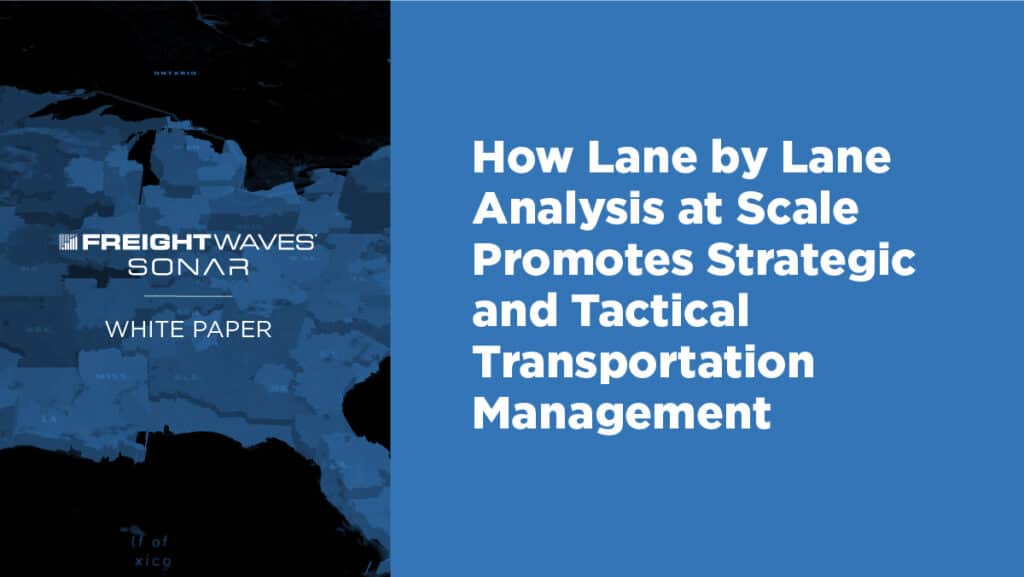The cost differential between dry van truckload and intermodal contract rates expanded to multiyear highs over the winter as trucking costs expanded much more rapidly than the intermodal freight counterpart. Todd Maiden reported Wells Fargo believes 2021 will be a banner year for container shipping on the rails, citing strong year-over-year comps and sustained import growth. But we have already heard Union Pacific announce “peak-season” surcharges in the upcoming months as West Coast volumes have been challenging to handle. It is only a matter of time before rates and the cost of shipping on the two modes converge, and there are much bigger challenges looming in the form of reimagined supply chains.
This past week FreightWaves rail and intermodal freight expert Mike Baudendistel wrote about the newly released Intermodal Contract Savings Index, which compares all-in dry van to intermodal contract rates, and broke down the reasons intermodal has a decisive cost advantage when the freight market tightens, reports Baudendistel via FreightWaves.com. The cost differential expanded to 22.7% in December. Trucking pricing tends to be much more volatile thanks to much more dynamic networks and customer base.
Intermodal shipping is dominated by the largest shippers in the U.S. and operates on a more static network, which gains higher cost efficiency than trucking over longer-mileage runs, as further explained by the Association of American Railroads. Trucking has a decisive advantage on shorter, irregular runs moving in or out of less populated regions, which are also core reasons to view lane-by-lane market data too.

The chart shows the relationship between tight trucking markets and increasing cost variance between dry van truckload and intermodal shipments. As carriers reject more load offers, represented by the Outbound Tender Reject Index (OTRI), trucking rates increase as shippers fall down their provider lists or route guides. Carriers positioned further down the list tend to charge higher freight rates.
If their routing guide fails completely, they end up on the spot market. When this happens over a longer stretch of time, as has been the case in the back half of 2020, some shippers renegotiate new trucking rates out of cycle. This rarely if ever happens on the intermodal side. Most of the costs are incurred in the form of temporary surcharges on the spot market, which represents a much smaller percentage of the overall volume than trucking.
With imports continuing to flood the ports and inventories still well below pre-COVID levels, intermodal freight should continue to have a strong year, but there are systemic risks once inventories are replenished and trucking stabilizes.
While there are always threats of companies sourcing from different places, the impacts to bottom lines in 2020 have increased the need for alternative sourcing, like switching from truckload to intermodal freight or vice versa, in order to mitigate risks to inventory levels.
This may mean reshoring to places like Europe or closer to home in North America. While not eliminating the need for containers, this could dramatically reduce the time spent on the rails as freight moves over shorter distances. Freight sourced in rural areas where costs are lower will not have the option of moving on the rail.
The increase in e-commerce will mean more warehousing with more focused inventory scattered across the country in areas with lower population density and less infrastructure — something less-than-truckload companies should benefit from.
The future supply chain model looks a lot more flexible. Though very efficient over long distances and cost-effective, flexibility and short movements are not intermodal freight strengths. The need for long-haul intermodal freight capacity moving more than 800 miles is not going away, but looking beyond 2021 there are some eroding factors the sector will need to address to grow.
Intermodal freight has always maintained some degree of independence from market volatility. While markets with high volatility and urgency among freight rarely end up with intermodal gains, there’s always a risk that market dynamics will change. Today’s shippers need to realize that intermodal, while great for ESG initiatives or other concerns, will not always be the best choice. And finally, using new IMCSI tickers within SONAR, it’s easier to make that call. Request a FreightWaves SONAR demo to see these tickers in action or by clicking the button below or a FreightWaves SONAR SCI Lane Acuity demo to get more on the value of lane-by-lane analyses today.
(Epilogue by Jason Vanover)
